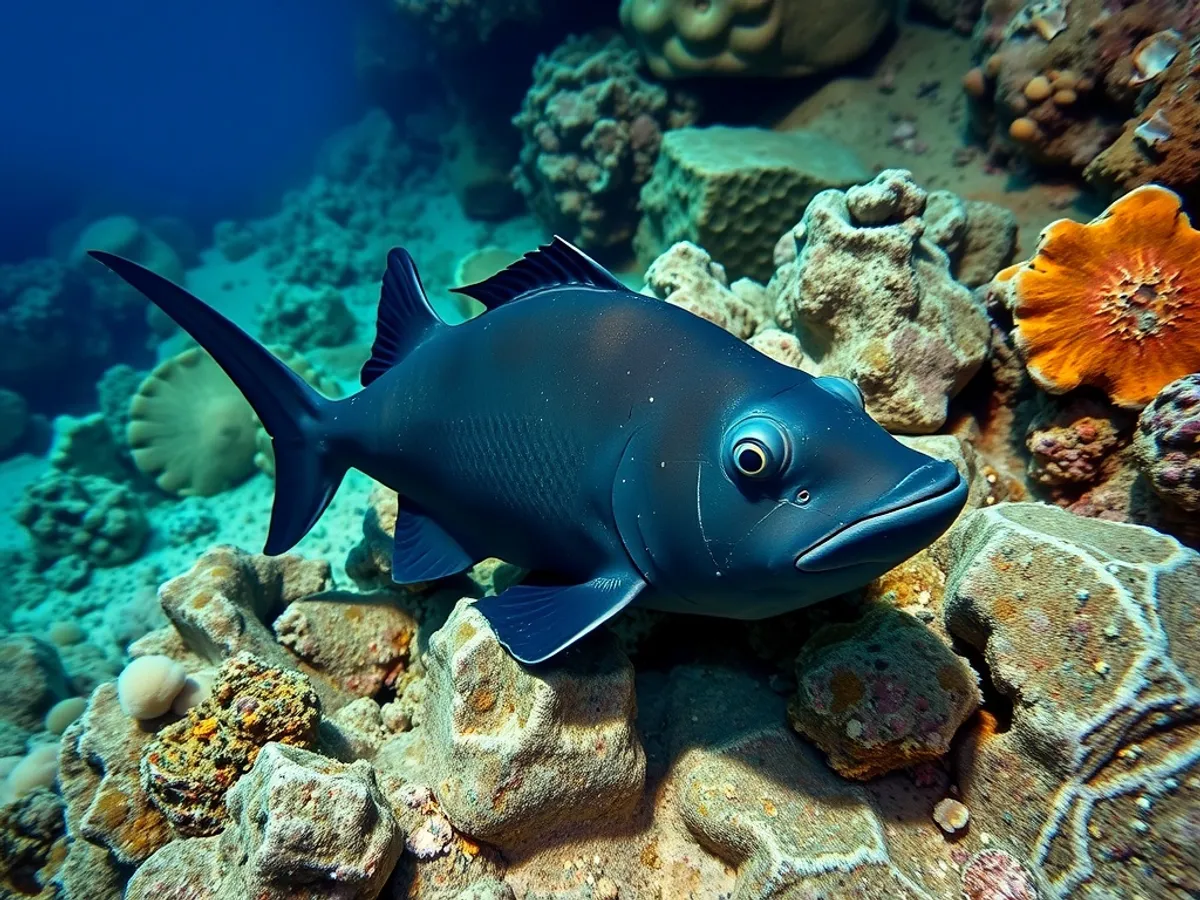
Atlantic spadefish
Chaetodipterus faber

Meet the Atlantic spadefish
The Atlantic spadefish is a striking, disc-shaped marine fish recognized for its silvery body adorned with bold, vertical black bands. Commonly found in large schools, it frequents coastal waters, shipwrecks, reefs, and piers along the western Atlantic Ocean. Juveniles often mimic dead leaves as camouflage, while adults are active swimmers that can be seen gliding gracefully through the water. This species is highly adaptable and social, contributing to its abundance in suitable habitats.
Classification
Fish
Habitat
Coastal marine waters, reefs, and shipwrecks
Diet
Omnivore
Lifespan
8-10 years
Conservation
Least Concern
Weight
2–9 kg (4.4–20 lbs)
📖Fascinating Facts
Bandit Appearance
The Atlantic spadefish's vertical black bars give it a masked, bandit-like look that helps with camouflage among shadows and structures.
Schooling Behavior
These fish are highly social and may gather in schools of hundreds, making them an impressive sight in their natural habitats.
Flexible Diet
Atlantic spadefish feed on a variety of foods, including small crustaceans, mollusks, plankton, jellyfish, and algae.
📋Detailed Description
The Atlantic spadefish (Chaetodipterus faber) is a laterally compressed, deep-bodied fish reaching up to 91 cm (36 in) in length, though most adults average 30–45 cm (12–18 in). Its body is strikingly disc-shaped, with a high dorsal fin and a long, sloping anal fin, both of which contribute to its distinctive silhouette. The coloration is silvery with four to six prominent, vertical black bands running down the sides, which fade with age. The mouth is small and terminal, equipped with brush-like teeth suited for scraping and picking food. Juveniles are darker and often mimic floating debris or dead leaves, providing camouflage from predators. Adults are highly social, forming large, dense schools that can number in the hundreds, especially around reefs, shipwrecks, and man-made structures. The species is omnivorous, feeding on a wide variety of benthic invertebrates, small crustaceans, mollusks, jellyfish, and occasionally algae. Atlantic spadefish are active swimmers, using their laterally compressed bodies for agile maneuvering among complex habitats. Their scales are small and cycloid, providing a smooth texture and reducing drag in the water.
💡 Did you know?
Despite their bold appearance, Atlantic spadefish are not aggressive and rely on schooling for protection from predators.
🔬Research & Sources
Wikipedia Summary
The Atlantic spadefish is a species of marine ray-finned fish belonging to the family Ephippidae, the spadefishes. It is the symbol of the North Carolina Aquariums.
Last Modified: 4/12/2024
🎭Behavior & Social Structure
Atlantic spadefish are diurnal and exhibit strong schooling behavior, often forming tight aggregations for both foraging and protection against predators. These schools are typically found in shallow coastal waters, especially near reefs, wrecks, and pilings. Feeding occurs primarily during daylight hours, with individuals grazing on benthic invertebrates, zooplankton, and occasionally cnidarians such as jellyfish. They use coordinated movements to flush out prey from the substrate or water column. Social hierarchies within schools are not well documented, but the species displays synchronized swimming and rapid changes in direction to evade threats. Juveniles are solitary or form small groups, relying on their mimicry for protection. At night, spadefish may disperse slightly but generally remain in the vicinity of sheltering structures.
👶Reproduction & Life Cycle
Spawning occurs in late spring through summer, typically from May to September, varying by latitude. Atlantic spadefish are oviparous, with external fertilization. During spawning, adults form large aggregations in open water, where females release pelagic eggs that are fertilized by males. There is no parental care; eggs and larvae are left to drift with the currents. The eggs hatch within 24–48 hours, and larvae are planktonic for several weeks before settling in shallow, protected habitats such as seagrass beds or mangroves. Sexual maturity is reached at approximately 2–3 years of age, when individuals are about 20–25 cm (8–10 in) in length.
🛡️Adaptations & Survival
The Atlantic spadefish's laterally compressed body and high dorsal and anal fins allow for exceptional maneuverability in complex reef environments. Its coloration and banding provide disruptive camouflage, breaking up the fish’s outline and making it less visible to predators. Juveniles exhibit remarkable leaf-mimicry, both in color and behavior, drifting motionless to avoid detection. The species’ omnivorous diet and specialized dentition enable it to exploit a wide range of food sources, from hard-shelled invertebrates to gelatinous zooplankton. Schooling behavior enhances predator avoidance and foraging efficiency. Physiologically, spadefish tolerate a range of salinities and temperatures, allowing them to inhabit estuarine as well as fully marine environments.
📚Research Sources
🎨Cultural Significance
The Atlantic spadefish holds regional significance as the official symbol of the North Carolina Aquariums, reflecting its abundance and visibility in local waters. It is a popular species among recreational anglers and divers due to its striking appearance and schooling behavior. While not a major commercial species, it is occasionally consumed in local fisheries. The species does not have a prominent role in folklore or mythology but is valued for its ecological role and as an indicator of healthy reef systems.
🔬Recent Research & Discoveries
Recent research has focused on the species’ role in coastal reef ecosystems, particularly its impact on benthic invertebrate populations and its interactions with artificial reefs. Studies using stable isotope analysis have revealed dietary shifts between juvenile and adult stages, highlighting the species’ ecological flexibility. Genetic studies have confirmed low population structure across its range, suggesting high larval dispersal and connectivity. Ongoing research is examining the effects of habitat modification and climate change on recruitment and population dynamics. The Atlantic spadefish is also being studied as a model for understanding schooling behavior and anti-predator strategies in reef fishes.
🎥Wildlife Videos

David Attenborough Presents: Tasmania - Weird & Wonderful | Free Documentary Nature
David Attenborough presents: Tasmania - Weird & Wonderful | Wildlife Documentary Watch 'David Attenborough's Ant Mountain' ...
Free Documentary - Nature

From Sea Snakes To Parrotfish: Life on Indonesia's Equatorial Reefs | All Out Wildlife
In Indonesia's equatorial waters, life thrives among vibrant coral reefs. These reefs host an astonishing array of fish species; with ...
All Out Wildlife

David Attenborough | Nature Documentary To Fall Asleep To (ai)
"Life on Earth" is your gateway to the breathtaking world of wildlife and natural wonders. Through captivating documentaries, we ...
Life on Earth - David Attenborough

Amazing Encounter with Atlantic Spadefish! GoMEDIA Underwater Photography Course Highlights
For more information and reservations, please visit http://www.utiladivecenter.com/ Follow us on facebook ...
GoPro Utila Dive Centre

David Attenborough's | Tasmania | Weird and Wonderful
Attenborough narrates the story of a vast island wilderness - ancient forests, pristine rivers and spectacular coastline. Seasons ...
symmetry

Alpine Rivers: The Cradle of Life | Free Documentary Nature
Alpine Rivers: The Cradle if Life | Nature Documentary Watch 'Alpine Lakes - An Enchanting Underwater World' here: ...
Free Documentary - Nature
🌍Habitat Information
The Atlantic spadefish typically inhabits Coastal marine waters, reefs, and shipwrecks environments. Atlantic spadefishs have adapted to their environments with specialized features and behaviors.
Primary Habitat:
Coastal marine waters, reefs, and shipwrecks
More detailed habitat information will be available soon.
🛡️Conservation Status
The Atlantic spadefish is currently classified as Least Concern. Conservation efforts are crucial for preserving this species for future generations.
Common Threats:
- 🏠Habitat loss and fragmentation
- 🌡️Climate change impacts
- 🎯Hunting and poaching
- 🏭Human-wildlife conflict
⚠️Threats & Conservation Challenges
Currently, the Atlantic spadefish faces few significant threats and is classified as Least Concern by the IUCN. However, localized pressures include habitat degradation (especially of reefs and coastal structures), pollution, and incidental capture in commercial and recreational fisheries. Overfishing is not a major concern due to the species’ high fecundity and adaptability, but ongoing coastal development and water quality decline may impact juvenile nursery habitats. Climate change and ocean acidification could pose future risks by altering prey availability and habitat structure. Population trends are stable, but continued monitoring is recommended.
🔬Scientific Classification
Scientific Name
Chaetodipterus faber
Classification Hierarchy
🔍 About Taxonomic Classification
Taxonomic classification is a hierarchical system used by scientists to classify and organize living organisms based on shared characteristics and evolutionary relationships.
The system moves from broad categories (Kingdom) to increasingly specific ones, with each animal's scientific name typically consisting of its Genus and species.
📝Community Notes
Share your observations and insights about the Atlantic spadefish with our community of wildlife enthusiasts.
Join Our Community
Sign in to share your observations and connect with fellow wildlife enthusiasts.
Sign In to ContributeNo community notes yet
Be the first to share your observations about the Atlantic spadefish!
Explore Atlantic spadefish
Select a tab above to learn more about this amazing animal.
📸Photo Gallery
No photos available for this animal yet.
🌟Discover More Wildlife
Continue your journey of discovery with more fascinating animals from our database
